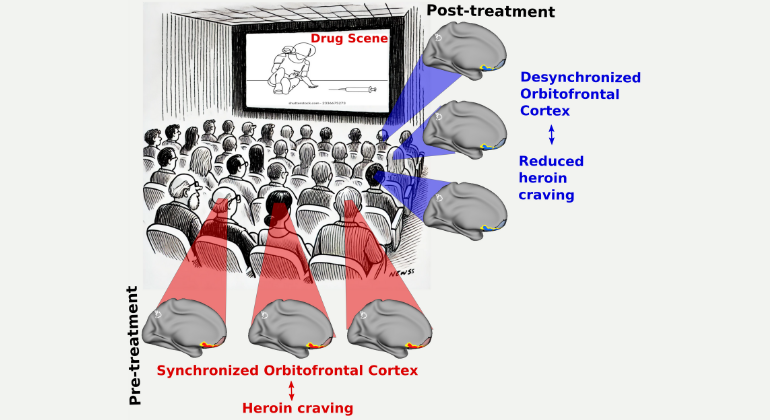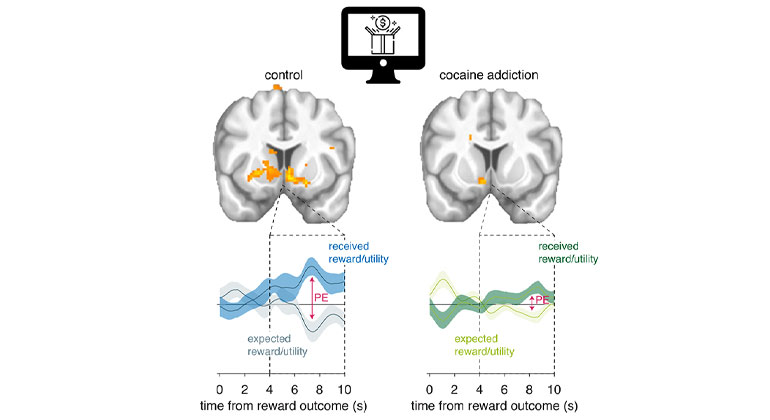Human Drug Addiction Behaviors Closely Tied to Specific Impairments Within Six Large-Scale Brain Networks
Systematic review of task-related neuroimaging studies found addicted individuals demonstrate increased activity in these networks during drug-related processing but decreases across all other functions
Specific impairments within six large-scale brain networks during drug cue exposure, decision-making, inhibitory control, and social-emotional processing are associated with drug addiction behaviors, according to a systematic review of more than 100 published neuroimaging studies by experts at the Icahn School of Medicine at Mount Sinai and published Wednesday, June 6 in the journal Neuron.
Drug addiction is a disorder that encompasses not only excessive drug-seeking and taking, but also fundamental changes in cognition and emotional processing. It comprises core clinical symptoms and behavioral manifestations including a chronically relapsing cycle of intoxication, bingeing, withdrawal, and craving that propels uncontrollable drug use despite adverse consequences and a reduction in the pleasure derived from the drug. While much of the early research on drug addiction focused on understanding the rewarding properties of the drug, recent research has made it increasingly clear that cognitive and emotional impairments support the initiation, escalation, and maintenance of the cycle of addiction. A better understanding of the underlying impaired neural mechanisms in human drug addiction is critical to paving the way for the development of more targeted, evidence-based treatment interventions and timely prevention approaches.
The Impaired Response Inhibition and Salience Attribution (iRISA) model, first published in 2002 by Rita Goldstein, PhD, Professor of Psychiatry and Neuroscience and Director of the Neuropsychoimaging of Addiction and Related Conditions research program at the Icahn School of Medicine at Mount Sinai, and Nora Volkow, Director of NIDA, proposed that impairments of two broad neuropsychological functions—response inhibition (a cognitive process that permits individuals to inhibit their impulses) and salience attribution (the property of tagging something as valuable or important)—and their underlying neural substrates contribute to the cycle of addiction across a broad range of substances of abuse. The iRISA model uses multiple neuroimaging modalities including magnetic resonance imaging, electroencephalogram (EEG) and derived event-related potentials, positron emission tomography, and neuropsychological testing to explore the underlying neurobiology of human drug addiction and the shift to excessive salience attributed to the drug and drug-related cues at the expense of other salient reinforcers as associated with impaired self-control (especially in a drug related context) and increased drug taking in drug addicted individuals.
“We conducted the current review to update the iRISA model with the most recent evidence from the neuroimaging literature by systematically reviewing 105 task-related neuroimaging studies published since 2010,” says Dr. Goldstein, last and senior author of the paper. “We found consistent impairments in brain function in six large-scale brain networks during performance of different tasks. While the involvement of these specific brain networks was task-specific, we generally observed that in a drug-related context (e.g., during exposure to drug cues) drug addicted individuals had increased engagement of the brain networks underlying decision making, inhibitory control, and social-emotional processing, but a blunted response during non-drug related tasks, as predicted by the iRISA model.”
Specifically, the Mount Sinai study team assessed brain function in drug addiction across a number of brain networks, including findings from whole-brain analyses of significant group differences. They organized the results across six large-scale brain networks that showed impairment of brain function in addiction, encompassing the “reward network,” which includes subcortical and cortical brain regions activated during the appraisal of subjective value; the striatal “habit network,” which underlies learning of automated behavior; the “salience network,” regions involved in (re)directing attentional resources toward salient stimuli; and the “executive network,” which supports the selection of possible behavioral responses (often also named the inhibitory control network).
Two additional networks, which were not discussed in prior reviews of the iRISA model, were found to be relevant to brain function in drug addiction: the “self-directed network,” which is activated during self-directed/referential cognitive processes, and the “memory network,” involved in flexible, multi-cue learning and memory.
“Our review is the first systematic approach to integrate what we know about the function of each of these networks into a comprehensive model underlying drug addiction symptomatology across the addiction cycle,” says Anna Zilverstand, PhD, Assistant Professor of Psychiatry at the Icahn School of Medicine at Mount Sinai and first author of the paper. “We demonstrated common deficits underlying drug addiction independent of the primary drug of choice, which are associated with measures of daily, real-life, drug use and which predict onset, escalation, and relapse into drug use. Our work could inform the development of treatments specifically targeted to alleviate these brain-behavioral deficits.”
About the Mount Sinai Health System
Mount Sinai Health System is one of the largest academic medical systems in the New York metro area, with 48,000 employees working across seven hospitals, more than 400 outpatient practices, more than 600 research and clinical labs, a school of nursing, and a leading school of medicine and graduate education. Mount Sinai advances health for all people, everywhere, by taking on the most complex health care challenges of our time—discovering and applying new scientific learning and knowledge; developing safer, more effective treatments; educating the next generation of medical leaders and innovators; and supporting local communities by delivering high-quality care to all who need it.
Through the integration of its hospitals, labs, and schools, Mount Sinai offers comprehensive health care solutions from birth through geriatrics, leveraging innovative approaches such as artificial intelligence and informatics while keeping patients’ medical and emotional needs at the center of all treatment. The Health System includes approximately 9,000 primary and specialty care physicians and 10 free-standing joint-venture centers throughout the five boroughs of New York City, Westchester, Long Island, and Florida. Hospitals within the System are consistently ranked by Newsweek’s® “The World’s Best Smart Hospitals, Best in State Hospitals, World Best Hospitals and Best Specialty Hospitals” and by U.S. News & World Report's® “Best Hospitals” and “Best Children’s Hospitals.” The Mount Sinai Hospital is on the U.S. News & World Report® “Best Hospitals” Honor Roll for 2025-2026.
For more information, visit https://www.mountsinai.org or find Mount Sinai on Facebook, Instagram, LinkedIn, X, and YouTube.

